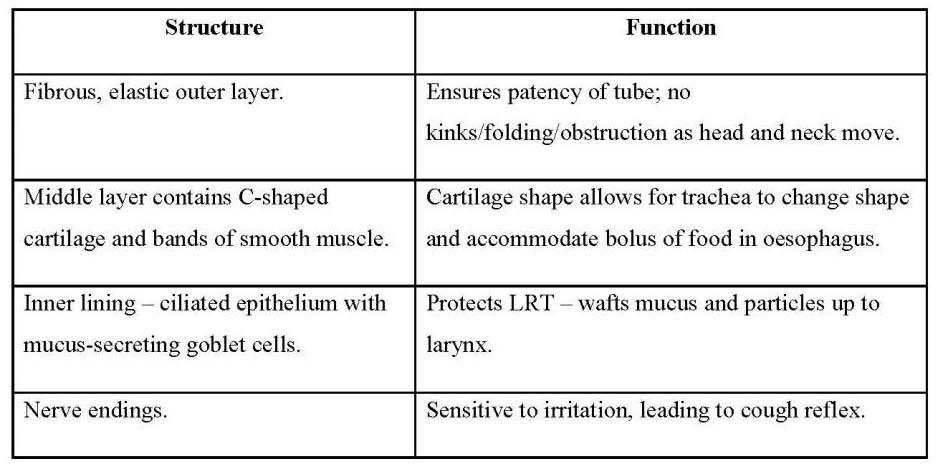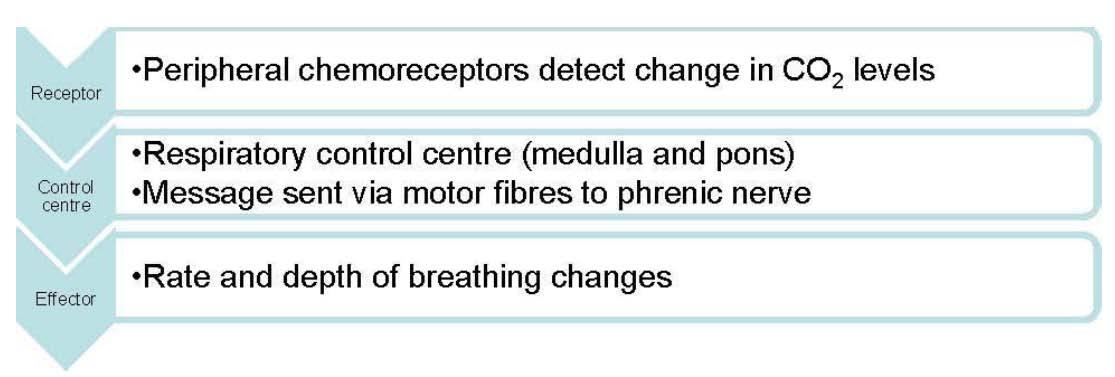Essentials of Anatomy and Physiology for Nursing Practice
Second Edition
by Neal Cook, Andrea Shepherd and Jennifer Boore
Student Resources
Answers to Revise Questions
Outline the functions of the respiratory system.
Ans:
- Providing an extensive area for gas exchange between air and circulating blood
- Moving air to and from the exchange surfaces of the lung
- Protecting respiratory surfaces from dehydration, temperature changes or other environmental variations and defending the respiratory system and other tissues from invasion by pathogens
- Producing sounds involved in speaking, singing and non-verbal communication
- Providing olfactory sensations to the central nervous system from the olfactory epithelium in the superior portion of the nasal cavity
Identify the structures of the upper respiratory tract and describe their functions.
Ans: Nose and nasal cavity
- Primary passage for air entering the respiratory tract
- Air enters into the vestibule – flexible tissues of nose
- Epithelium of vestibule contains course hairs that extend across the external nares. Large airborne particles get trapped and are prevented from entering the nasal cavity.
- The nasal septum divides into right and left portions. The superior portion is the olfactory region.
- Conchae: increase the surface area, contain a large number of blood vessels which deliver heat and moisture and secrete a large amount of fluid which helps keep the nasal cavity clean.
Pharynx
- Hollow muscular structure lined with epithelial tissues, begins behind the nasal cavities and divided into three sections:
- Nasopharynx – air breathed in through here, it contains lymphatic tissue (adenoid) and eustachian tubes.
- Oropharynx – air breathed through nose and mouth passes through here, anything that is swallowed goes through here also. Contains tonsils. During swallowing the uvula and soft palate move into a posterior position to protect the nasopharynx and nasal cavity.
- Laryngopharynx – part of both the respiratory and digestive system and is lined with non-keratinised stratified squamous epithelium. Posteriorly the laryngopharynx extends from the epiglottis to the oesophagus carrying food and fluid to the stomach; anteriorly it conducts air to the larynx.
Larynx
- Semi-rigid structure composed of several types of cartilage connected by muscle and ligaments that provide movement of the vocal cords to control speech.
- Thyroid and cricoid cartilage provide structure and support for the airways to ensure they don’t collapse and block airflow in and out of the lungs.
- Glottis – opening that leads into the larynx and eventually the lungs.
- Epiglottis – leaf shaped fibrocartilage flap-like structure located above the opening. It has selective closure, that is, the glottic/sphincter mechanism closes over the larynx when you swallow and opens when you breathe.
- Vocal cords – area of division between upper and lower airways. Lower airway starts below the vocal cords.
Describe the structure and function of the trachea
Ans:

Explain how alveoli are adapted to ensure that gas exchange takes place.
Ans:
- Alveolar ducts and alveolar walls are made from a single layer of simple squamous epithelial cells.
- The thin cells of the respiratory bronchioles and alveoli are surrounded by a network of capillaries in which respiratory gases are carried.
- The blood gases cross the alveolar and the capillary membranes.
- The alveoli must remain inflated to enable this gaseous exchange to occur and specialist cells produce a substance called surfactant which prevents the alveoli collapsing during expiration.
Describe the process of respiration.
Ans: The process by which oxygen and carbon dioxide are exchanged between the atmosphere and body cells consists of three distinct phases:
- Pulmonary ventilation (breathing) – the inhalation (inspiration) and exhalation (expiration) of air involving the exchange of air between the atmosphere and the alveoli.
- External respiration – the diffusion of gases between the alveoli and the pulmonary capillaries across the respiratory membrane. O2 diffuses from the alveoli to the pulmonary capillaries, whereas CO2 moves in the opposite direction, that is, from the pulmonary capillaries to the alveoli.
- Internal respiration – the diffusion of gases between blood in the systemic capillaries and the tissues. O2 diffuses from the systemic capillaries to the tissues and CO2 moves in the opposite direction, that is, from the tissues to the systemic capillaries.
Explain how the rate and depth of ventilation are controlled.
Ans: The depth and rate of ventilation are controlled through a control system which uses negative feedback to regulate homeostasis.
The respiratory system has two main functions:
- maintaining PO2 at normal levels so that it supplies adequate O2 to the cells;
- by removing CO2 from the body it maintains CO2, and thus pH, within normal limits.
Nervous control
- Centres in the CNS control fundamental respiratory pattern.
- Depends partly on respiratory control centre located partly in the medulla and partly in the pons.
- Motor fibres extend into the spinal cord through the cervical region to the phrenic nerve to the diaphragm.
Chemical control
- Chemoreceptors – sensitive to chemicals dissolved in body fluids
- Centrally – brain stem
- Peripherally – carotid and aortic bodies
- Respond to CO2 level in circulating blood
- Presence of hydrogen ions and its effect on decreasing pH – stimulate central chemoreceptors
- Increased CO2 triggers ventilation
- Peripheral chemoreceptors – contain sensory neurons that respond mainly to a decrease in O2 supply. Not usually involved in regulating breathing (does not act until O2 levels very low).

Explain what is meant by the term ‘partial pressure’ and identify the proportions of gases contained within atmospheric air at sea level.
Ans:
- Atmospheric pressure (760 mmHg) is the sum of all gases in the air, that is, nitrogen (N2) (78%), oxygen (O2) (21%), argon (Ar) (0.93), carbon dioxide (CO2) (0.04%), variable amounts of water (H2O) (0–4% depending on where you are), plus small quantities of other gases (0.06%).
- Partial pressure = the proportion of total air pressure exerted by the particular gas, i.e. the amount of any particular gas in solution is in direct proportion to the partial pressure exerted by the gas in the air surrounding it.
- e.g. at sea level, the atmospheric pressure of the air = 760 mmHg (mercury);
- O2 is 21% of air, therefore the partial pressure of O2 (PO2) is 21% of 760 = 21/100 × 760 = 160 mmHg.
Discuss how oxygen and carbon dioxide are transported.
Ans: Oxygen transport:
- Small amount transported in plasma (1.5%).
- Almost all binds with haemoglobin in RBCs (98.5%).
- A haemoglobin molecule has four iron-containing haem regions.
- Each binds with one molecule of O2.
- To enter cells O2 must separate from haemoglobin.
- O2 is released into areas where O2 concentration is low.
Carbon dioxide is transported in three forms:
- 7% dissolved in plasma, on reaching the lungs it diffuses into alveolar air and is exhaled.
- 23% combines with the protein portion of haemoglobin and plasma proteins to form carbaminohaemoglobin.
- 70% transported as bicarbonate ions. As the CO2 diffuses into the systemic capillaries it reacts with water, in the presence of carbonic anhydrase it forms carbonic acid (H2CO3) which easily dissociates into hydrogen (H+) and bicarbonate (HCO3–) ions:

